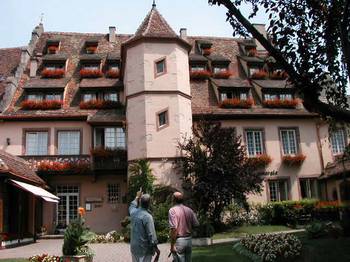 |
A
friend back in the U.S. just told me on the phone that we lead a charmed life. In
many ways that is true, but let me take a moment to say that our world isn't
perfect. But this journal is not the place to talk about those things. We have
been through tremendous changes this year (e.g., moving three times), and the state of the
world (particularly US foreign policy) troubles us greatly -- it even affects our family
in a very direct way. I know people from other countries are reading this journal,
because I've heard from them by e-mail. Let me say that this journal is in no way
indicative of how Americans live, and it isn't even a complete picture of how Tom and I
live. Only our closest friends and family know about the things that really bother us. And that's the way it will stay. |
||||||||||||||
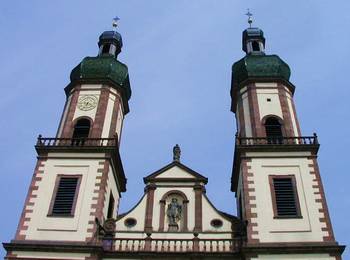 |
Now,
back to the journal. You haven't heard from me for days because we were in Alsace on
Friday and Saturday, and yesterday was Bastille Day and we were busy with Bastille day
things. Our very dear friends from Germany planned this weekend in Alsace. All we had to do was show up. We took the train from the Gare de l'Est in Paris to Strasbourg -- a four-hour trip. Our wonderful friends picked us up in front of the station there and off we went to Selestat for lunch. Selestat, about 40 kilometers from Strasbourg, is one of what must be dozens and dozens of extremely charming villages in Alsace. Lunch was at the Hostellerie Abbaye La Pommeraie (upper left photo), 8 avenue du Marechal Foch, 67600 Selestat, telephone 03-88-92-07-84. It was terrific. |
||||||||||||||
|
Lunch
cost about a hundred dollars. It was a wonderful lunch, but two of us didn't have
dessert because we knew we'd be having a gourmet dinner as well. Our wonderful
friends know how to find the best places to eat. It is a treat to do this once in a
while, to really splurge and go all out on gourmet food, but we definitely can't do this
very often. We toured the hotel a bit before lunch. It was once part of a Cistercian abbey. Everything has been renovated to perfection. It would be a good place to stay, costing about 132 to 193 euros per night. After lunch, we drove to another village, Orschwiller, to see the Saint-Maurice Abbey Church - the only example of Austrian baroque art in France. It is richly ornamented. The pictures at left are from this church. I love the lightness of it. The first church here was built on the ruins of a temple dedicated to Mercury, and it housed the relics of Saint Maurice. |
||||||||||||||
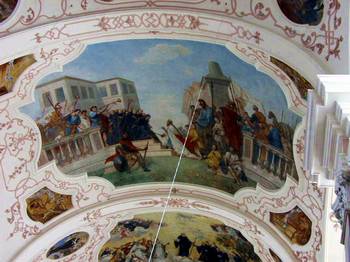 |
It
was the Abbaye of Ebermunster, one of the oldest monasteries in the province. There were older, roman and gothic churches that preceded this one on this site. This structure was finished in 1683. The decor, all the glorious painting, was done in 1696 or later. A new facade, with two towers, was added in 1709-1710. The entire church was renovated in the 1720s, perhaps following a fire. We were delighted that the organist was practicing during our visit. The organ in this church is very special -- it has an airy, light, heavenly sound, yet it is powerful! |
||||||||||||||
 |
It
is one of the last organs built by the famous Andre Silbermann (1678-1734) from
Strasbourg. It took him two years, from 1730 to 1731, to complete it. Its
exterior was based on the design of the original organ in Saint-Germain-des-Pres in Paris.
That organ no longer exists; it was a masterpiece by Pierre and Alexandre Thierry.
The organ was lovingly restored in 1939 by Edmond-Alexandre Roethinger. He preserved its integrity, and therefore its sound qualities. Again the organ was restored in 1999 by Gaston Kern, and again great care was taken to preserve its sound. So, now this instrument is one of the most joyously authentic French organs from the 18th century. We thanked our friends for thoughtfully arranging to have the organist there at the time of our visit. |
||||||||||||||
|
Wood
statue of Samson, by Clemens Winterhalder (1693-1696). Alsace, like much of France, is known for its wines. There are seven grape varieties in Alsace:
During our visit, I managed to taste the pinot noir, the riesling, and the pinot gris. The riesling is dry, thank goodness. It is all very good. Recently, I discovered Cremant in Paris. It is a sparkling wine produced by the traditional method of fermentation in the bottle. The one I tried in Paris was a chardonnay, and it was much like champagne. I've learned now that cremants are made from the pinot blanc, pinot gris, and pinot noir grapes from Alsace, and they are now some of the most popular sparkling wines (other than champagne) in France. I must try some.
|
||||||||||||||
 |
In
the car, our friends told us about the history of Alsace, which of course we had studied
in school. But it was much more fun to hear it from them, our dear friends who are
German but who are also French in some ways, much like Alsace. The architecture, and all the flowers everywhere, appealed to my German blood. I became increasingly convinced, over the course of the weekend, that I must visit Germany soon. We may well go there in June next year. Tom thinks I'll really like it. I think he's right. With food, however, I think I prefer the French. But German food is a good diversion. One can tire of French food after a long time, believe it or not. And there is nothing like that Alsatian dish at Stephane Martin's (in the 15th in Paris), the jarret de porc (pork roast) on red cabbage cooked in honey. Yummm. |
||||||||||||||
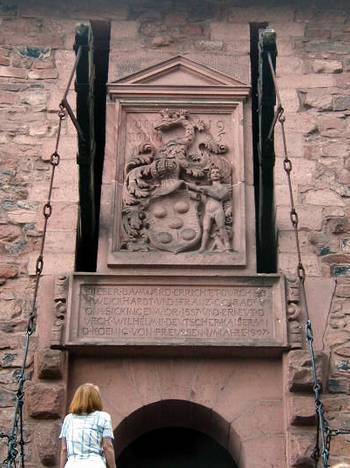 |
After
Ebermunster, we drove to the Chateau du Haut-Koenigsbourg, a grand medieval castle that
was a ruins, restored to castle status in 1901-1908 by architect Bodo Ebhardt. I think the experts are not sure of its true age, but we know it was first mentioned in the 12th century. Located on top of a mountain at the junction of what was once the wheat and wine road and the salt and silver road, the castle was given as a fief to the Tiersteins by the Hapsburgs in 1479. During the Thirty Years War, the castle was successfully defended for a while by Captain Phillippe de Liechtenau, but finally fell to the Swedes who then looted and burned it. In 1865, the town of Selestat became the owner of the ruins and gave them to the German Emperor William II of Hohenzollern (the Kaiser) in 1899. Of course this is during a time when Alsace was part of Germany. William II is the one who hired Bodo, the architect, and the work began. William continued to build his collections until 1918. In 1919, France became the owner of Haut-Koenigsbourg. The castle is huge. It covers 1.5 hectares, and it built mostly of pink stone. At left, our friend enters the castle at the drawbridge over a pit where bears were once kept. |
||||||||||||||
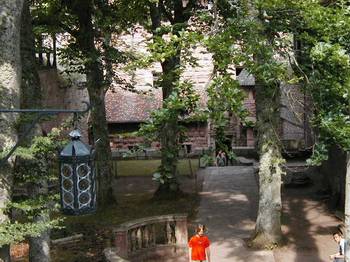 |
While
the exact age of the castle isn't exactly known, it is known that it was largely rebuilt
in 1479 to meet the needs of artillery. Bodo and William had the goal of making the castle not a residence but a museum of the Middle Ages. William also was interested in establishing it as a symbol of German presence in Alsace. At left is the inner courtyard of the castle. |
||||||||||||||
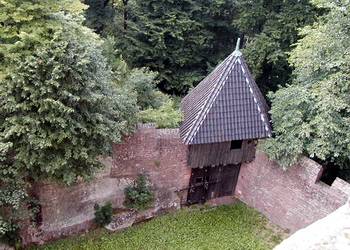 |
At left, looking down at the outer, lower wall from one of the towers. | ||||||||||||||
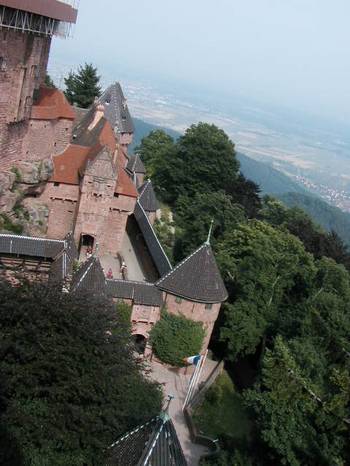 |
The views from the towers were magnificent. It is difficult to really see the view here because there is a haze, just like in the Smoky Mountains. The haze is just moisture, however. We really appreciated being out of the air pollution we've been experiencing in Paris. Alsace seemed fresh and clean, bright and white, and very happy to greet us. | ||||||||||||||
| <Previous More from Alsace> |

